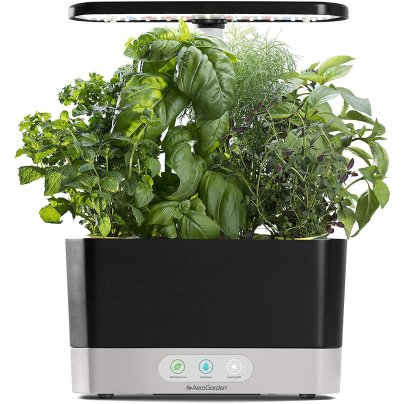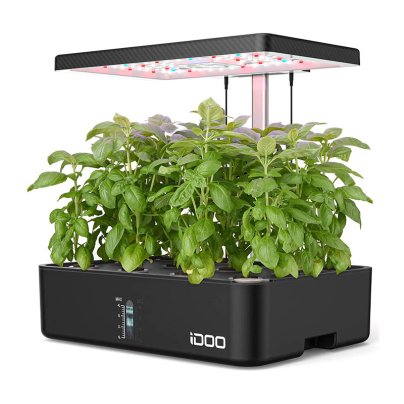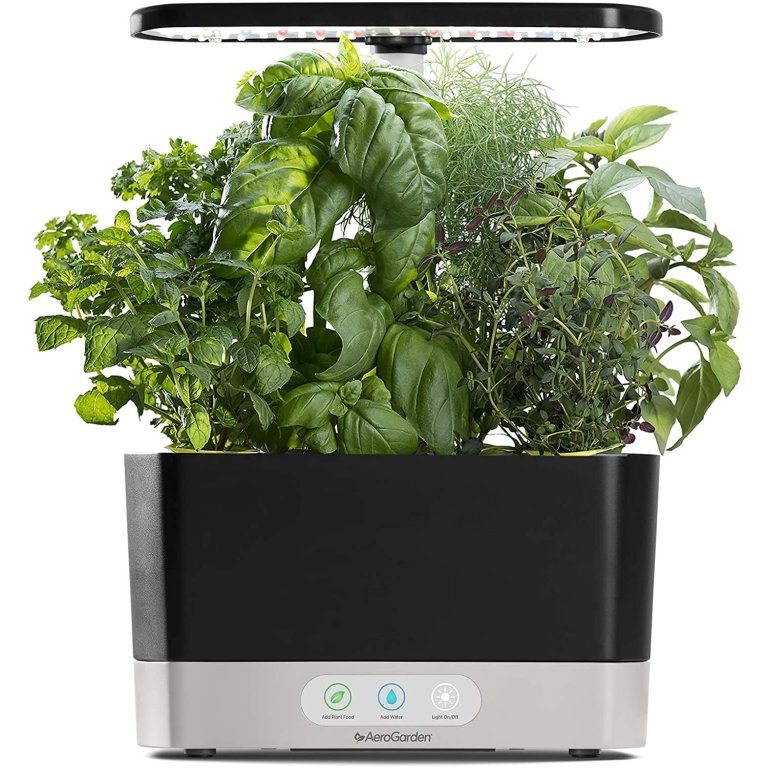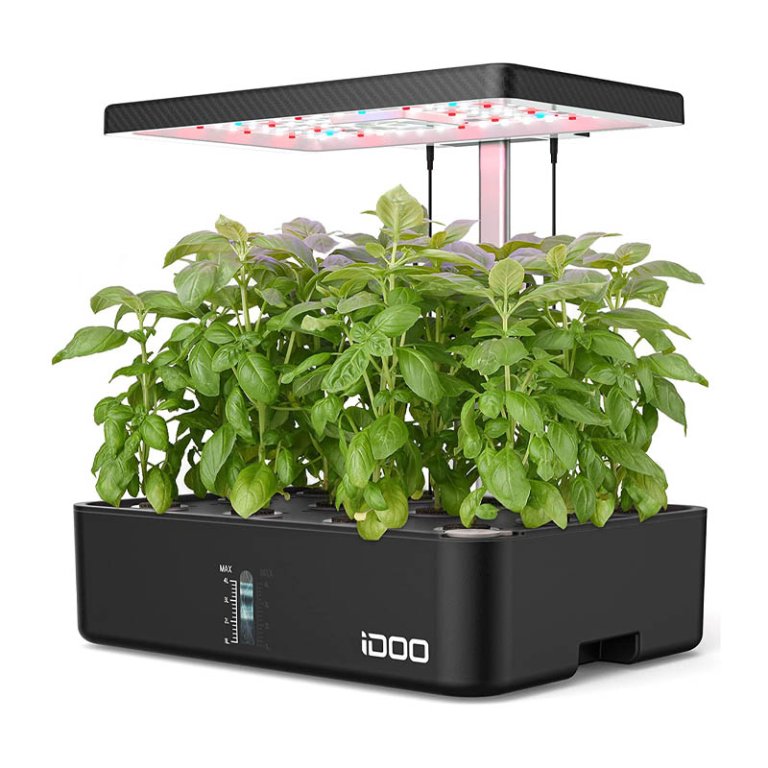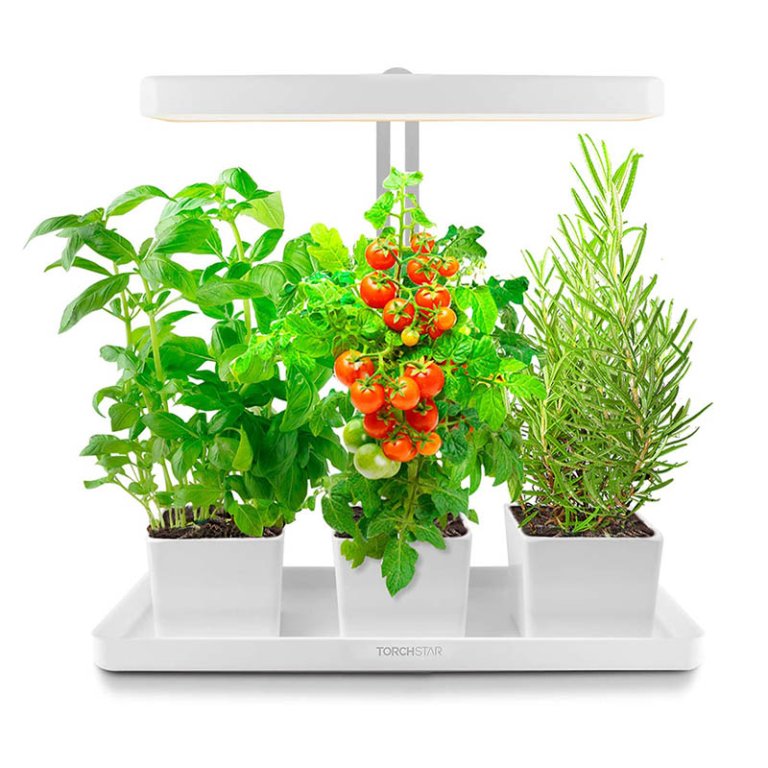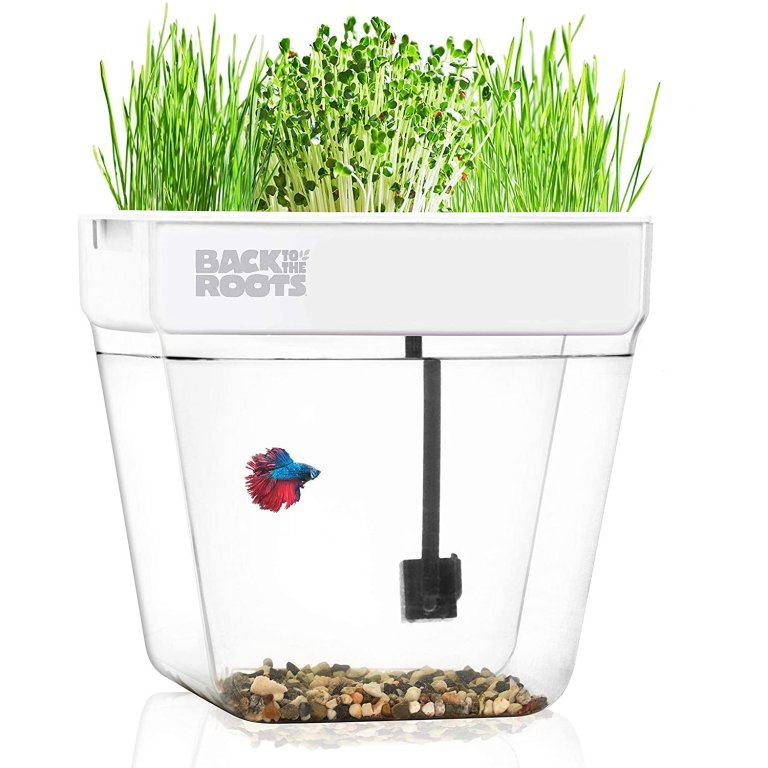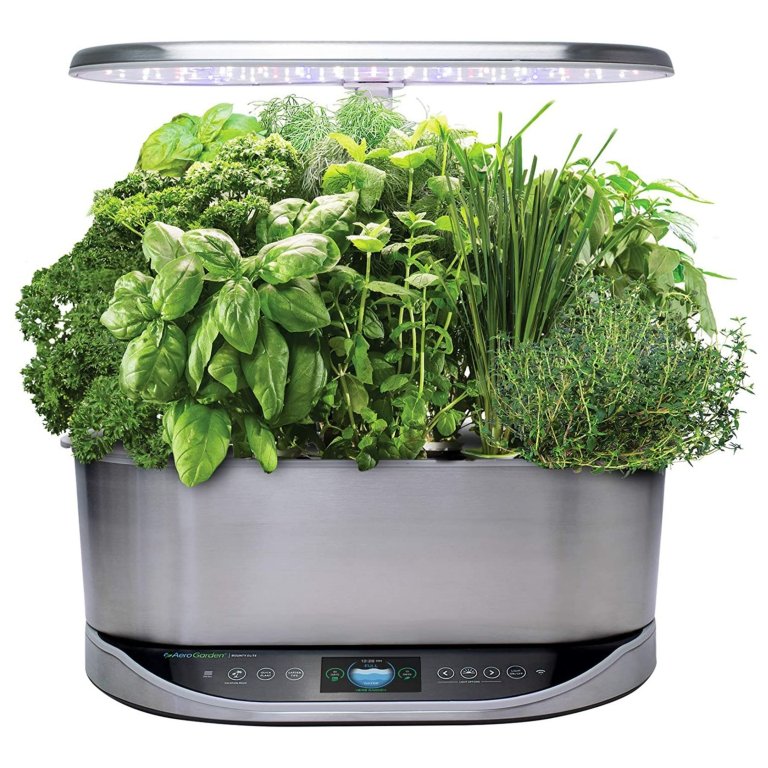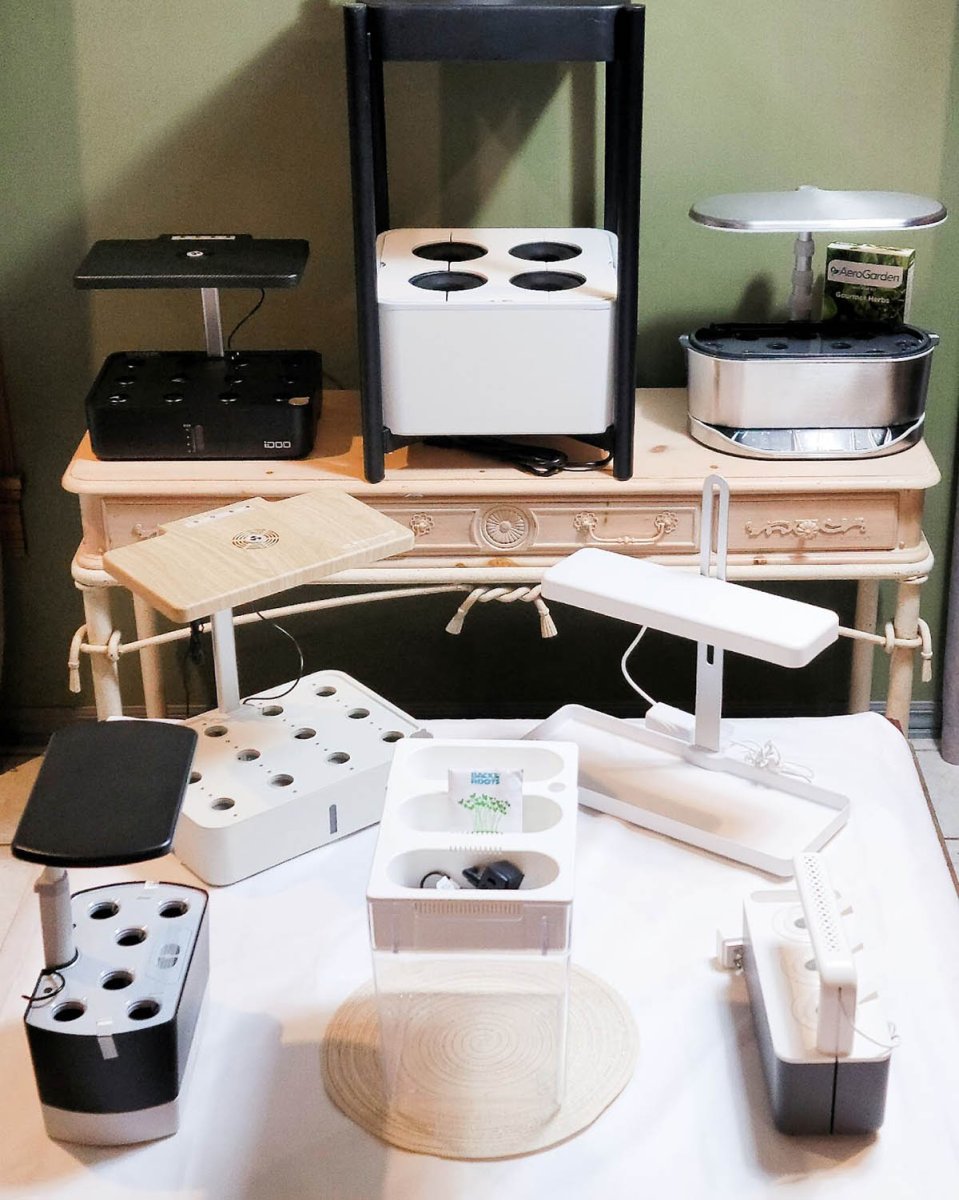
We may earn revenue from the products available on this page and participate in affiliate programs. Learn More ›
Indoor gardens are fun additions to virtually any space, and they’re especially well suited to those who love cooking with fresh herbs or enjoy colorful blossoms in the winter. Indoor gardens can be soil-based systems, but most are hydroponic, meaning the plant’s roots grow only in water. But how well do they perform in real-world conditions? To learn whether the claims made by the manufacturers of these growing systems are true, we put them to the test.
We selected a variety of the most popular indoor gardens to see which ones were best suited for growing healthy plants. We carefully followed each manufacturer’s seed-sowing instructions and then waited for tiny seedlings to appear. All functions on each model were tested, and the plants’ success was monitored. The highest-scoring indoor gardens earned a spot on this lineup—however, not all of the products we tested made the cut.
The best indoor garden is low maintenance, attractive, and functional. Check out these top picks when shopping for an indoor garden and find out what we discovered about each model we tested—both the pros and the cons.
- BEST OVERALL: AeroGarden Harvest 2.0 Indoor Garden
- RUNNER-UP: iDOO 12 Pods Indoor Garden Kit
- BEST BANG FOR THE BUCK: Torchstar LED Indoor Garden Kit
- BEST AQUAPONIC GARDEN: Back to the Roots Indoor Aquaponic Garden
- BEST SMART GARDEN: AeroGarden Bounty Elite Indoor Garden
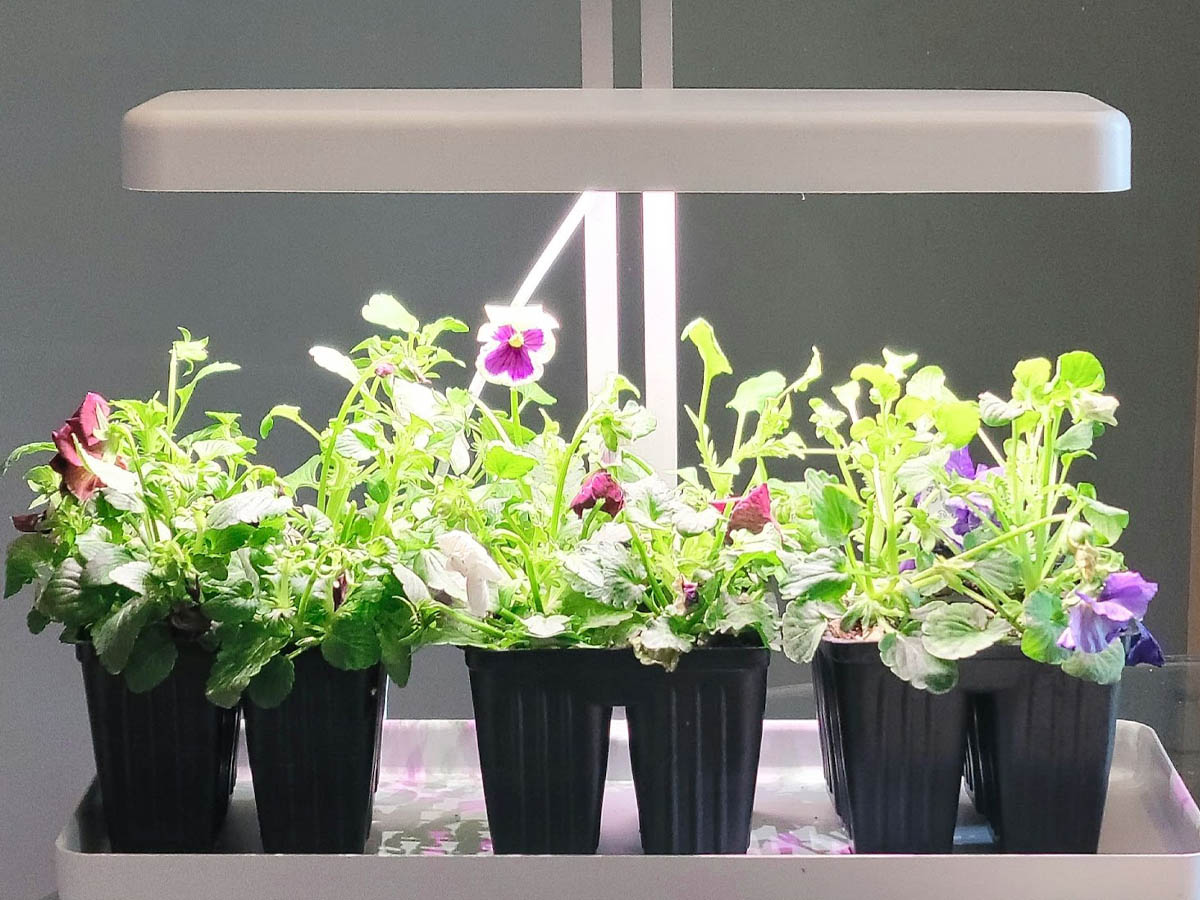
How We Tested the Best Indoor Gardens
In selecting indoor gardens for our tests, we looked at well-known brands—AeroGarden is a leader in the industry—but didn’t automatically eliminate lesser-known companies if the units were well-made and had beneficial features. We tried to test various indoor garden types that would suit a wide range of users.
Indoor gardens are only worth the investment if they can produce healthy herbs, flowers, or other plants, such as leaf lettuce. To accomplish that—if they’re hydroponic—they must keep the pods consistently moist until the seeds germinate and also provide an ample amount of full-spectrum light that mimics sunlight. Our primary goal in testing the indoor hydroponic gardens was to determine whether they could provide the environment necessary for plants to thrive.
We only had one soil-based indoor garden, but to make the cut, it had to provide sufficient light to keep our little seedlings alive.
We assembled the indoor gardens as instructed and then filled the hydroponic models with filtered reverse osmosis water. We adjusted the settings, such as light panel height, synced the smart models with Wi-Fi, and then observed the plants over the next 4 weeks, noting how quickly the seedlings grew and how healthy they appeared. We added water and fertilizer when prompted (or every 2 weeks). We used a rubric to record our observations, and we awarded points based on ease of use, quality of design and materials, and how well the included functions performed.
At the end of the testing, we tallied the points and used them to determine the awards in this lineup.

Our Top Picks
The following indoor gardens offer a range of features—some automatically turn the lights on and off; others come with fans to adjust humidity. Some prompt the user to add water or fertilizer, while still others offer growing tips. The one thing they all have in common is that each performed well enough in hands-on tests to earn a spot in our lineup of the best indoor gardens.
Best Overall
AeroGarden Harvest 2.0 Indoor Garden
See ItPros
- Pre-seeded herb pods included with purchase; comes with basil, parsley, dill, thyme, Thai basil, and mint
- Grow lights come with an on/off timer that mimics sunlight to accommodate multiple plant varieties
- Water and fertilizer reminders for added user-friendliness and convenience
- Adjustable-height light panel for small and large plant types
Cons
- Roots became entangled, making them difficult to remove
Product Specs
- Type: Hydroponic
- Light type: Full-spectrum LED
- Added functions: Water circulation, light timer, water and fertilizer alerts
The AeroGarden Harvest 2.0 Indoor Garden comes ready to go with six pods and non-GMO seeds (basil, parsley, dill, thyme, Thai basil, and mint). The kit also includes plant food. AeroGarden is arguably the top name in indoor gardens; right out of the box, it was clear this indoor garden was designed to grow fresh, delicious herbs.
We filled the water tank with filtered water from a reverse osmosis (RO) system, adjusted the LED light as close as possible to the surface of the grow deck, and dropped the pre-seeded pods into the growing ports. Lights are on a timer, so all we had to do was hit the power button. The lights automatically followed a 16-hour-on, 8-hour-off schedule. Every 30 minutes or so, a gentle trickling could be heard, which indicated a pump within the tank circulating the water.
We found there was nothing more to do—except wait. In 6 days, we spotted teeny seedlings in the cores of some of the grow pods. Within 2 more weeks, all the seeds had sprouted, and the herbs varied in height from about 1 inch to 3 inches. After that, they grew rapidly, bolstered by plenty of light and liquid fertilizer. Every 14 days, the AeroGarden Harvest prompted us—via a bright green light—to add more fertilizer to the tank, and when the water level dipped too low, a bright blue light appeared, reminding us to add water.
Measuring 11 inches by 8 inches by 15 inches, this indoor garden is small enough to fit on a kitchen counter and comes in a choice of white or black to match. As a soil-free system with nutrients delivered directly to the roots, its plants grew quickly and we were harvesting small snips for cooking in just 4 weeks.
Get the AeroGarden Harvest indoor garden at Amazon.
Best for Beginners
iDOO 12 Pods Indoor Garden Kit
See ItPros
- Lights come with a timer to accommodate multiple plant varieties
- Gentle fan mimics a light breeze; promotes aeration and proper growth
- 12 grow pods included with purchase; suitable for herbs, flowers, and other plants
Cons
- No fertilizer included with purchase; may need to be bought separately
Product Specs
- Type: Hydroponic
- Light type: Full-spectrum LED
- Added functions: Water circulation, grow lights timer, gentle fan
Those new to indoor gardening may do well with the iDOO 12 Pod Indoor Garden Kit. We found it easy to set up and stocked with everything needed to get growing—except seeds. This garden is self-watering, the lights are automatic (16 hours on, 8 hours off), and gentle fan cycles on once every 30 minutes. It also includes water-soluble granular fertilizer and instructions on how to add it to the tank.
The iDOO has a large tank, and in our 4 weeks of testing, we never had to add any water since the roots were still so small that they didn’t use much. By the time we were done testing, there was still more than half a tank. That said, we knew from experience that the larger plants get in a hydroponic system, the more water they use and the more often the tank requires filling.
We added a bit of all-purpose liquid vegetable fertilizer to the tank every 2 weeks, starting with planting the seeds in the pods. The iDOO indoor garden measures 10.5 inches high by 13 inches wide by 11 inches deep, making it well suited to a kitchen countertop or even a table.
Get the iDOO indoor garden at Amazon.
Best Bang For The Buck
Torchstar LED Indoor Garden Kit
See ItPros
- Well suited to hold multiple potted plants; perfect for plants, flowers, and herbs
- Light panel adjusts up to 18 inches for larger plant varieties
- Grow lights come with a timer to accommodate multiple plant varieties
Cons
- No seeds, pots, or watering capabilities provided
Product Specs
- Type: Light panel and drip-tray only (soil-based)
- Light type: Full-spectrum LED
- Added functions: Lights on a timer
We found the budget-friendly Torchstar Indoor Garden Kit to be just the ticket for growing small plants or starting seedlings in grow mix. It comes with an adjustable light panel that can be extended up to 18 inches, making it suitable for supplying light to short or tall plants. This indoor garden has an automatic timer (16 hours on and 8 hours off). However, it doesn’t include pots or seeds, so we tested it with some violet seedlings we planned to transplant outdoors afterward. The tray is 17 inches wide and just under 8 inches deep, so we placed it along the back of a countertop where it was out of the way.
This simple indoor garden provides full-spectrum grow lights and a drip tray for retaining water that runs through the pots, but we had to do all other gardening duties ourselves. Still, the light seemed to encourage the violets to grow—even without being fertilized—and we were able to raise the light panel when plants got close to the light.
This cost-effective kit is a great pick for a traditional indoor growing situation. It doesn’t feature a lot of bells and whistles, but it will keep plants healthy by offering sufficient light even in a dim room. Seeds, soil, and pots are the user’s choice.
Get the Torchstar indoor garden at Amazon or Walmart.
Best Aquaponic Garden
Back to the Roots Indoor Aquaponic Garden
See ItPros
- Mimics natural ecosystem conditions to accommodate fish and take care of plants
- Learning tool included with purchase; helpful for first-time users
- Suitable for growing microgreens, succulents, bamboo, and other houseplants
Cons
- No light included with purchase; may need to be purchased separately
- Lava rocks must be carefully washed between crops
Product Specs
- Type: Aquaponic
- Light type: No lights
- Added functions: Always-on water circulation
At first, we were slightly puzzled as to why the water tank on the Back to the Roots aquaponic garden was so large—that is, until we discovered it’s supposed to hold fish. This indoor garden is hydroponic in the sense that the roots of the plants are not anchored in soil, but the addition of a fish puts it into the “aquaponics” category.
The kit includes fish food, a water pump, and organic microgreen seeds. We borrowed a few goldfish for our tests (and returned them safely afterward!). The kit comes with a large package of wheatgrass seeds and another of radish seeds. We opted for wheatgrass and followed the instructions for sprinkling the seeds over water-absorbent lava rocks in three grow bins located at the top of the unit.
When the pump is connected and plugged in, it constantly pulls water from the tank and disperses it in the lava rocks to keep the seeds and tiny roots wet. The wheatgrass sprouted in just a few days while the fish swam happily in the tank below. In a natural aquaponic setting, fish waste fertilizes the plants, and decomposing bits of plants feed the fish. This is a small rendition of an aquaponics system, so the fish required daily supplemental feedings as well.
This system doesn’t come with a light, so we placed it near a northern window where it wouldn’t get direct sunlight—we feared direct sun rays might overheat the water, although the kit didn’t come with that warning. This aquaponic garden is low maintenance, and it’s an excellent way to teach children about ecosystems. While it will produce sprouts and microgreens, we felt its true value to be its educational aspect.
Get the Back to the Roots indoor garden at Walmart.
Best Smart Garden
AeroGarden Bounty Indoor Garden
See ItPros
- Very sleek-looking design; suitable for offices, living spaces, and kitchens
- Syncs with Wi-Fi via a downloadable app for monitoring and adjusting
- Adjustable light panel built-in
- Offers information, tips, and alerts to help first-time users
Cons
- Not all the pods germinated, and some were incorrectly labeled
Product Specs
- Type: Hydroponic
- Light type: Full-spectrum LED
- Added functions: Water circulation, timer, Wi-Fi compatible, water and fertilizer alerts
It doesn’t get much more intelligent than the AeroGarden Bounty Elite Indoor Garden. As we unpacked the Bounty Elite, we were impressed with its sleek stainless steel tank (that matched our stainless steel appliances) and its adjustable light panel—and that was only the start.
The Bounty Elite resembles other AeroGarden hydroponic systems, although it’s larger than most, with 12 grow pods. The pods come pre-seeded, so we popped them into the grow ports and filled the tank with filtered water. The herbs included a variety of basil, parsley, thyme, and mint. The pod labeled “dill” never germinated, but the pod labeled “thyme” grew a dill seedling.
The Bounty Elite features a full spectrum of colored light waves that gives off a slightly violet glow. Like the other AeroGarden we tested, this one came with liquid fertilizer. We can’t say whether the AeroGarden fertilizer is better than the all-purpose product we used in the other gardens or whether the LED light was better—but the herbs in this garden excelled during our tests.
For tech-savvy users, the smart compatibility of this model is a dream. As soon as we turned the unit on, it walked us through the Wi-Fi setup without a hitch. We were able to monitor the water level from our smartphones, and when it was time to add water or fertilizer, we received an alert. In addition to all that, the Bounty Elite offers dimmable lights and displays growing tips on the LED screen and the downloadable app. All in all, we found it highly functional and really liked how well the app worked. The unit stands 17 inches high when the light panel is fully extended; it’s 16 inches wide and measures 10.5 inches from front to back.
Get the AeroGarden Bounty indoor garden at Wayfair.
ALSO TESTED
Click and Grow Smart Garden 3 Indoor Herb Garden
We really wanted to like the Click and Grow Smart Garden 3 Indoor Herb Garden. Right out of the box, we fell in love with its sleek design—at less than 5 inches wide, it fits in several narrow spots, including some windowsills. It came with three pre-seeded grow pods and an extendable LED light arm that could raise as the seedlings grew.
The LED light on the Click and Grow was so bright, it was hard to see the tiny plants when it was on, but the lights were on a timer so we didn’t worry about turning them on and off.
However, the Click and Grow had one fatal flaw, which became apparent about 2 weeks into the testing: It didn’t come with a pump to circulate the water as the other hydroponic systems did. Although we used filtered water from a reverse osmosis system, it wasn’t long before the surface of the tiny grow pods developed a thin, white layer of mold. Soon after, the seedlings all succumbed. After further researching the Click and Grow, we discovered other users had the same experience.
As great as the Click and Grow is in some aspects—it has a nifty floating water level indicator that allowed us to see when it was time to add water—the lack of a pump was a deal breaker. We hope to see the manufacturer update this model to include a pump in the near future, because without one, the chances of the water stagnating and leading to mold or other fungal diseases are just too great.
Jump to Our Top Picks
What to Consider When Choosing an Indoor Garden
There are various factors to keep in mind when looking for the best indoor garden for your home or office. Decide whether you wish to grow flowers or herbs, want a soil-based or hydroponic system, and how much maintenance you can put in. We took the following into consideration during our tests.
Size
The size of your ideal indoor garden will depend on a few factors. You’ll obviously need it to fit in the available space you have for it. A few herbs, for example, won’t take up much space, but avid cooks who frequently reach for an assortment of herbs will want to dedicate as many as nine to 12 plants in an indoor garden. In addition to area, consider the height of plants: Vegetables tend to grow tall and require ample room.
Plant Type
Most indoor gardens are designed to grow herbs, but some can successfully grow flowers, too, especially if the plants are relatively small—typically less than a foot tall and wide, such as miniature daisies.
The exception is large-scale indoor gardens that offer extra room for plants to grow and come with light panels large enough to disperse light over widespread foliage. While manufacturers often show images of indoor gardens with plants laden with tomatoes and cucumbers, a system that will accommodate such vegetables is the exception, not the rule.
System Type
Indoor herb gardens grow plants using soil, hydroponic, or aquaponic systems. Soil-based indoor gardens use a traditional potting mix, similar to outdoor gardens. Hydroponic systems use water that directly delivers added nutrients to the roots of plants; no soil is required.
Aquaponic systems are similar to hydroponic systems in that there’s no soil, but they include a perhaps surprising additional component. Fish live in the water that nourishes the plants, and their waste makes fertilizer to enhance plant growth. As the plants utilize the waste, the process helps keep the tank clean and the fish healthy. In short, it’s an ecosystem.
Grow Lights
All plants need light to grow, so evaluating an indoor garden’s grow lights is essential. Most indoor gardens come with LED grow lights, which mimic natural sunlight for vigorous plant growth. Some even have automatic dimming features to further mimic sunlight throughout the day.
Those who are unable to spend much time taking care of a garden may do well with a model that has lights on an automatic timer. Many keep the lights on 16 to 18 hours a day for optimal growth. However, some indoor gardens don’t have a built-in light source, so check whether the unit contains lights before purchasing.
Temperature Regulation
Sustaining the right temperature for an indoor garden is essential. Very few indoor gardens include temperature regulators, so where you place your unit is key. For best results, locate an indoor garden where temperatures will stay between 65 and 75 degrees Fahrenheit. Avoid spots where the temps are frequently cooler than 60 degrees or warmer than 80 degrees.
Though an indoor garden likely won’t need a heater, consider adding an aquatic one for an aquaponic system for the tropical fish in the tank if not so much for the plants.
Humidity
Many herbs and other plants prefer humidity, so consider how to keep your plants moist. The light panel on top of many indoor hydroponic gardens can function as a humidity dome to help retain humidity at the plant level but not enough that the leaves become damp.
While some humidity is a good idea, too much can lead to the development of fungal diseases. If the indoor garden will be located in a humid area, such as a greenhouse, consider purchasing a system that comes with a built-in fan that cycles on every few minutes to help dissipate excess humidity.
Maintenance
Many want a low-maintenance indoor garden system that requires very little hands-on attention. In general, aquaponic systems will require the most maintenance, since they feature living creatures that must be monitored and fed. In contrast, hydroponic systems require very little attention beyond adding water and fertilizer occasionally. A traditional soil system will require a bit more hands-on effort, which makes them a good choice for teaching kids about nature.
FAQs
Take good care of your indoor garden and it will likely reward you with some beautiful and healthy plants in any season. If you aren’t sure you’re maintaining an indoor garden correctly or want other information, read on for answers to some common questions about these products so you can enjoy fresh herbs, flowers, and veggies throughout the year.
You can grow many plants indoors, but most indoor gardens are best suited to growing herbs or small flowers. Other plants like succulents are commonly grown indoors, but these plants are capable of growing in planters or terrariums.
As long as they have the proper nutrients and adequate space, virtually any plant can grow in a hydroponic system. The size of the plant is a determiner here—smaller plants, such as herbs, are better suited to most indoor gardens than are larger vegetable plants.
A general rule is to add water every 7 to 10 days, but follow the instructions supplied with your indoor garden to determine how much and how often to feed. The number of times plant food is required also depends upon the plant types you are growing.
Fill the tank with filtered water and add water treatment, which should be included, to make the water suitable for aquatic life. Then add the fish to the tank, and attach the pump that comes with the system to keep the water oxygenated for the fish. Once the fish are established, sow microgreen seeds in the trays above the tank. The pump will keep the seeds damp and promote sprouting.
If your system is healthy, you won’t need to change the water very often. If it gets murky, however, change it with fresh water and then treat the water before putting the fish back in.
Meet the Tester
Glenda Taylor is a product tester and writer specializing in the construction, remodeling, and real estate industries. She and her husband own a general contracting company, and Taylor is experienced in both residential and commercial building applications. She tests a wide range of power tools as well as other home improvement, household, and lawn-and-garden products.
